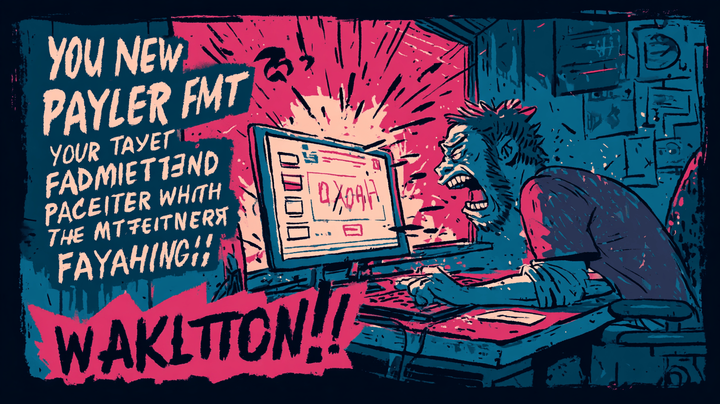How to deal with angry customers

I have never been good at dealing with customers. That’s a bad thing when you run a business. Traditionally, the main two reasons for this have been an humongous ego and a total lack of empathy (I am an ENTJ after all… but I don’t believe in any of that sh*t of course 😁).
Luckily for me, stoicism helped me tame my ego, and Esther, my Chief of Customer support, helped me understand the importance of seeing things from the point of view of the customer and empathizing with them to understand how they feel and why they react the way they do.
In this post, I want to share why you should put your ego, pride and emotions aside when you deal with angry customers. Why? Because they become the problem, not the customers. If you realize this, you can reverse an ugly situation. Worst case scenario, you may prevent this customer for becoming a hater, and best case scenario, you can actually turn a foe into a friend.
A recent example…
Some days ago, I received an email from an angry customer. It was sent to my customer support team, but included me in CC. This customer had recently switched from our main competitor to us.
The email stated that the LHV integration of our tool Companio was not working for him, and then added this sentence:
Please, fix these problems. Having switched from the competition, your platform is a lot worse, and more bothering for the user for the same price.
Taking a deep breath
This email did hurt. A lot. First, because of the months and months of effort put into it. Working non-stop, including weekends, 12-14 hours a day during the last 3-4 weeks.
But also because that was not true! The platform is in BETA, so it may have lots of errors right now, but it is the most powerful tool available in the market. It allows you to do things no other platform allows for e-Residents, like managing employees, virtual office packages and letters, multiple bank integrations in multiple currencies, etc.
So obviously my first reaction was very emotional. I was super upset with this guy. My first impulse was telling him to switch back to the competition and leave us alone… Good job Ignacio.
Then I took a deep breath, stopped my flow of thoughts and realized I was letting my emotions take over. So instead, I decided to apply what I’ve learned from stoicism and from Esther.

First thing first: ask yourself “Why?”
The first thing you need to do, after you realize you are in this loathing mindset, and manage to stop it, is asking yourself, “Why?”.
People are usually nice and reasonable. Except for some disturbed individuals –and I have unfortunately found some of them too– nobody writes an email like that one without a reason.
So why did this person write those words?
Then I re-read the email and realized the customer was right. The LHV integration was failing for some customers. LHV’s API is one of the worst I have found during my 20 years as an IT engineer, and the integration in Companio had some problems, especially, during the first days for some customers. He was one of them.
This is the first realization you need to do. Probably, customers are angry for a legit reason. And most probably, it is not their fault, but yours.
This is not a blame game, of course. In our case, we did our best, but LHV’s API is simply badly designed, prone to errors, and involves a custom onboarding process that cannot be fully tested until you launch it on production. Still, those are just excuses, and the customers obviously expected this to work flawlessly.
Empathizing with the customer
Then, the second important step, is considering how you would feel if the same happened to you. Probably very upset too. And it is perfectly understandable.
Yesterday, one of our customers tried to register a company with us but our payment gateway –Mollie– incorrectly detected this payment as a fraudulent operation and blocked not only this attempt, but all subsequent payment attempts from this customer, even with different cards.
This is not the first time this happens, and yesterday, after writing to their customer support, getting number 53 in the support queue, asking them to write me an email instead, and never getting an email back, I was extremely pissed off.
So I used this experience to imagine how this person would feel. Our excuses are as useless as Mollie’s ones. The fact is: something’s not working here, and it is not the fault of the customer.
Apologize
Once you analyze things from this point of view, the angst and loathing are completely gone. Instead, what you feel is the need to apologize to the customer.
So if you decide to write back, start with an apology. Understand the customers, empathize with them, and sincerely apologize. It is your fault they are experiencing these problems. No matter who was responsible for that. If it is someone from your team, you are the one who holds the ultimate responsibility.
Be sincere, be honest, and be humble. Remember that this person is paying you for a service, and the service is not working as well as expected. Yes, maybe the words were unfortunate, and the tone could have been better, but their reaction should be now understandable to you.

Then, and only then, defend your case
Only when you have apologized, and explained the customer how you can help them fix the situation, or assuring them that you will try to make up things as soon as possible, defend your case.
This is also a good opportunity for you to learn things that you or your company may be failing to accomplish.
In my case, I learned that we are not putting enough effort to promote Companio. It is a fantastic tool, and as I said, right now there is no other tool in the market offering what Companio offers. There is also no other provider offering everything we offer (support in Spanish, Russian, Ukrainian, French, English… multi-member companies, multi-bank and multi-currency support, etc…). So if some of our customers can’t see it, it is, again, our fault.
So I took the chance to also explain to the customer all the benefits of being our customer when compared to his previous provider, and made a mental note to do a better effort showcasing these benefits to the rest of the customers.
You will be surprised…
I was not sure what to expect when I clicked “Send”. But some hours later, I received an answer from this customer. This time, a very reasonable email apologizing for the tone of the previous email and promising to offer us valuable feedback to fix errors in the future.
Reading that email made me feel relieved. By stopping an emotional reaction to an understandably angry email from an angry customer, I managed to put myself into his shoes, realize that indeed, there is a problem there that is solely our fault, and redirect the situation to a more rational place.
This error is now fixed (we work fast 💪) and hopefully the customer is happier now and will write more constructive feedback in the future if he spots a glitch in the platform. And that is very valuable when your platform is still in BETA and you need feedback from the users.
Everybody wins.
Conclusion
During these years I have learned a lot of things about running a business, and I still learn new things every day. The most important lesson for me this week was that ego is the enemy of business. The stoics were completely right.
So next time you receive an email from an angry customer, don’t let your ego or your emotions take over. Understand that the problem is you, not the customer. Take a deep breath, ask yourself “why?”, empathize with the customer, apologize, and then (and only then) defend your case if you need to. Do this sincerely, and humbly. Everybody will win.




Comments ()